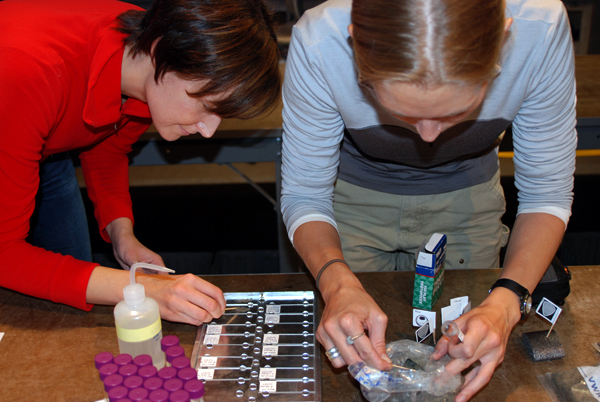
Photo Credit: Christina Riesselman/ANDRILL Project Iceberg |
Eva Tuzzi, left, and Christina Riesselman prepare smear slides of the ANDRILL sediment core. A smear slide is made by taking a little scrape of the sediment with a tool and then spreading it thinly on a glass microscope slide. A clear fixative is added to the slide to hold the sediment in place and then a cover slip is attached. |
Project overcomes drilling difficulties, eyes future sites for geologic discovery
Levy said there were some preliminary surprises. For instance, the rock types they recovered indicate the area around the drill site was once a shallow marine environment. Yet the water was 385 meters deep where the drilling operation was located on the sea ice — hardly kiddie pool depth.
That gives the team some hint about the basin history, about how quickly it actually deepened, according to Levy. “It was a bit of surprise to me, at least, and I believe to many of our sedimentologists,” he said.
Overall, the fossils and sediment deposits in this year’s core suggest a persistent warm period existed over an extended time during the middle Miocene, when the climate in the western Ross Sea and McMurdo Sound mirrored the modern conditions found in the southern tip of South America, southwestern New Zealand, and southern Alaska, rather than the cold polar climate of today.
“We now have a more complete core record from the middle Miocene and a step into a colder period of time, and that was one of our key targets,” said co-chief scientist Fabio Florindo of Italy’s National Institute of Geophysics and Volcanology in Rome. “It will tell an important story when we put together our recovery with the record of last season. This is exciting science, and it will echo loudly in the scientific community.”
The accomplishment is all the more astounding given the additional logistical challenges of operating a drill camp on the sea ice, where the platform is only a few meters thick versus tens of meters on the ice shelf. It’s not only a matter of stability, but also a race against the clock.
“The sea ice had to be sufficiently thick, stable and safe in the first place, and we knew we had to get all the equipment off it by about [Dec. 10] because [the ice] begins to seriously deteriorate — melting, cracking and lateral movement,” said Jim Cowie, ANDRILL project manager with Antarctica New Zealand, which handled the operations end of the drilling.
Fortunately, the sea ice was plenty thick, and support personnel were able to transport some 60 sledges of equipment and camp gear 40 kilometers to the drill site during the period known as Winfly, when a handful of flights arrive at McMurdo Station in August to begin prepping the station for its busy summer season, which starts in October.
“This put a lot of pressure on the support crew lead by Jonathan Leitch and assisted by Gerald Crist and his Fleet Ops team,” Cowie said.
The drilling also had its challenges, despite expectations that the older sediments would prove to be more compact and harder. In fact, the drillers, and Alex Pyne, ANDRILL’s drilling science coordinator from Victoria University of Wellington, had to overcome some very difficult “ground” involving moraine and sandy formations that are notoriously difficult to drill and recover intact cores from, according to Cowie.
“One section, at around 400 meters below sea floor, was particularly problematic and threatened an early end to drilling — this was a sandy formation which also contained water under pressure,” Cowie said. “Cool heads had to prevail to successfully drill through this zone.”
The accomplishment is not lost on Cowie, a veteran from a previous drilling campaign known as the Cape Roberts Project.
“It’s been a huge privilege to manage the operational and logistics side of two highly successful and rewarding, yet high-risk, scientific drilling projects — Cape Roberts Project and ANDRILL — over the last 14 years,” he said. “All this has been achieved safely by an extremely talented, dedicated and hard-working team of people in a high-risk and demanding environment.”
And they may not be done. The ANDRILL team has its sights set on additional drilling targets in the area, but current funding only includes two field seasons. That has not stopped the crew from surveying three more sites and planning scenarios for those operations.
“There are so many questions we have yet to answer,” Levy said. “We have to start now if we’re going to have any chance of drilling in the next few years.”
Discussing the prospect of another field season elicited mixed feelings for Levy. “That was kind of exciting … also, quite overwhelming. Here we are ramping down after a major effort and we’re already starting to build ourselves back up and inspire each other toward the next phase.
“We’re all pretty enthusiastic people, pretty highly motivated people, and we want to keep going.”
NSF-funded research in this story: David Harwood, University of Nebraska-Lincoln.
Back 1 2





